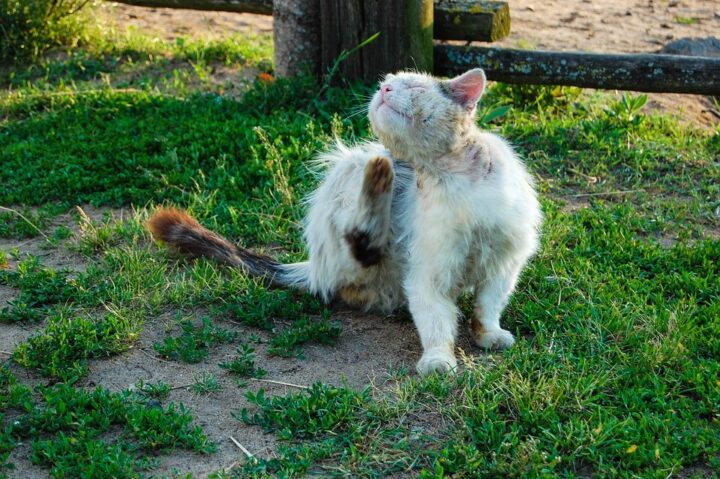Let’s face it fleas are annoying, nobody likes them and if your pet has them they can be a pain in the bum to get rid of. Using a monthly flea protection product is your best defence against fleas. There are a lot of great products on the market and many also offer ticks protection which is recommended for dogs. We offer spot-ons, collars and chews so there is something for every dog or cat. If using a spot on make sure you are applying it correctly and collars should fit snuggly so the product can work its way over your pet’s coat but you must be able to fit two fingers between your pet’s neck and their collar. Chews are simple – just make sure they swallow the whole thing as some are masters of deception and you may find a chew or tablet spat out and hidden under their bed!
ARE YOU APPLYING YOUR PET’S SPOT ON FLEA TREATMENT CORRECTLY?
Cat and dog spot on flea treatments are popular due to their effectiveness and often the easiest way to administer any form of flea treatment to your cat or dog. Instructions for application may vary so you should always consult the instructions provided with the cat or dog spot on flea treatment you have purchased, however here is a general guide on how to apply a cat or dog flea spot on.
- Try to choose a time to apply your spot on flea treatment when your pet is comfortable and relaxed (before bedtime is often a good time), always avoid having to pin any animal down to get them still enough to treat as this will create a negative association and may make future treatments difficult to administer. It can help to have someone helping you apply the treatment by giving your cat or dog treats to distract them while you apply the product.
- Also ensure any seal to treatment is broken before attempting to apply.
- Part your cat or dogs fur at the nap of the neck so you can see the skin underneath, it is the skin that you want to apply your spot on treatment too as this is how it is absorbed into the blood stream.
- For larger cats and dogs you will often find the dose of treatment needs to be applied on multiple areas, usually a 2-3 spots further along the spine, if this is the case your spot on flea treatment instructions will direct you to do this.
- Our final tip is to not squeeze the treatment out too quickly as if it is not given a few seconds to be absorbed onto the skin and the fur surrounding it, the spot flea treatment will roll off the animals coat and you will have only applied part of the full dose needed to fully treat/protect your pet.
Breaking the flea cycle
- REMOVE THE FLEAS FROM THE HOME
Wash your dog and/or cat.
Start at the neck so the fleas don’t jump up their body and hide around their face.
PLUS wash all their bedding, any soft toys, your bed sheets if they sleep or lay on your bed and cushion covers and throw from the sofa. Wash in a hot wash and if possible leave in the sun to dry. - VACUUM THE ENVIRONMENT
While the loose, potentially flea-infested items are being washed, arm yourself with a vacum and suck the flea life out of every surface, nook and cranny you can find. When you’re doing this, send the pets outside, or confine them to the bathroom, so that any fleas they’re carrying won’t jump onto the surface you just vacuumed and vice versa.
• Focus on areas that don’t get much exposure to sunlight (fleas like humid and cool spots), anywhere that you find dried blood and faeces (flea debris), upholstered furniture, and crevices around baseboards and cabinets (that’s where the eggs and larvae are probably hiding).
• When the vacuum bag is full, seal it in a plastic bin bag and put it in a covered bin container, preferably outside. Otherwise, the little buggers can crawl out and make themselves cosy again. - TREAT THE ENVIRONMENT
Flea bombs can be a great way to rid the house of those pesky fleas. Make sure you remove your pets for the day while the flea bomb is doing its thing. Alternately you can try a natural treatment and make a citrus spray. Slice a lemon thinly, add to a pint of water and heat to a boiling point. Let it sit overnight and in the morning, put the mixture in a spray bottle. Spray it onto areas where you suspect fleas hang out (beware of staining). Be sure to also rub it over your pet’s fur. Don’t soak, but dampen the fur. Do this once a month to combat fleas.
• Another way to make a citrus spray is to buy essential oils (available at natural food stores); you can buy a bottle of lemon oil and add 10-20 drops per ounce of water. - TREAT YOUR PET
There are a number of effective flea treatments you can use on your pet. These include monthly tablets, spot on treatments or sprays. Some include protection against certain intestinal worms, heartworm, ear mites and ticks. If you’re not sure which product is right for your pet ask your Vet or one of our friendly nurses for advice.
Importantly keep the treatment up all year long. Some people stop during the winter months when there aren’t so many fleas around but remember prevention is better than cure.
We often have clients in from all over including Wyee, Woongarrah, San Remo, Lake Munmorah, Summerland Point, Mannering Park, Chain Valley Bay & Blue Haven enquiring how best to treat fleas.


